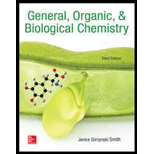
(a)
Interpretation:
The enantiomeric compound of W needs to be determined.
Concept introduction:
In chemistry, enantiomers are two stereoisomers that are mirror images of each other.
(b)
Interpretation:
The enantiomeric compound of Xneeds to be determined.
Concept introduction:
In chemistry, enantiomers are two stereoisomers that are mirror images of each other.
(c)
Interpretation:
The diastereomericcompound of Yneeds to be determined.
Concept introduction:
Diastereomers are compounds with same molecular formula, and also they should be non-mirror & non-identical stereoisomers.
(d)
Interpretation:
Thediastereomericcompound of Zneeds to be determined.
Concept introduction:
Diastereomers are compounds with same molecular formula, and also they should be non-mirror & non-identical stereoisomers.
Want to see the full answer?
Check out a sample textbook solution
Chapter 15 Solutions
General, Organic, & Biological Chemistry
- Draw all stereoisomers of the following compound and indicate which are enantiomers, disastereomers, or equal molecules.arrow_forwardWhat is the maximum number of stereoisomers possible for a compound with: (a) three stereogenic centers; (b) eight stereogenic centers?arrow_forwardIdentify pairs of molecules that represent enantiomers and diastereomers and identify each center stereogenic by writing R or S next to it.arrow_forward
- 1) Are the molecules A and B... conformational isomers? Diastereomers? Enantiomers? Position isomers? Non-related? 2) What about the molecules B and C? 3) What about the molecules C and D?arrow_forwardcis-1,2-Dimethylcyclohexane is optically inactive even though it has two chirality centers. Explain.arrow_forwardKetones react with alcohols to yield products called acetals. Why does the all-cis isomer of 4-tert-butyl-1,3-cyclohexanediol react readily with acetone and an acid catalyst to form an acetal, but other stereoisomers do not react? In formulating your answer, draw the more stable chair conformations of all four stereoisomers and the product acetal for each one.arrow_forward
- Following is a planar hexagon representation of L-fucose, a sugar component of the determinants of the A, B, O blood group typing. For more on this system of blood typing, see Chemical Connections: A, B, AB, and O Blood Group Substances in Chapter 25. (a) Draw the alternative chair conformations of L-fucose. (b) Which of them is more stable? Explain.arrow_forwarda. Draw the 14 constitutional isomers of molecular formula C8H9Cl that contain a benzene ring.b. Name all compounds that contain a trisubstituted benzene ring.c. For which compound(s) are stereoisomers possible? Draw all possible stereoisomers.arrow_forwarda. Draw the 14 constitutional isomers of molecular formula C8H9Cl that contain a benzene ring. b.Name all compounds that contain a trisubstituted benzene ring. c.For which compound(s) are stereoisomers possible? Draw all possible stereoisomers.arrow_forward
- Label the following pairs as A) distereoisomers, B) enantiomers, C) conformers, or D) the same. b1 c1 d1 e1 a2 b2 c2 The structures above are labeled a1, a2, b1, b2 ...etc. Using these labels, indicate which compounds above would have an optical rotation ofarrow_forwardHow many stereoisomers exist for BrHC=CHCH2CHFCl? A. 1 B. 2 C. 4 D. 8arrow_forward
 Organic Chemistry: A Guided InquiryChemistryISBN:9780618974122Author:Andrei StraumanisPublisher:Cengage Learning
Organic Chemistry: A Guided InquiryChemistryISBN:9780618974122Author:Andrei StraumanisPublisher:Cengage Learning
 Organic ChemistryChemistryISBN:9781305580350Author:William H. Brown, Brent L. Iverson, Eric Anslyn, Christopher S. FootePublisher:Cengage Learning
Organic ChemistryChemistryISBN:9781305580350Author:William H. Brown, Brent L. Iverson, Eric Anslyn, Christopher S. FootePublisher:Cengage Learning Macroscale and Microscale Organic ExperimentsChemistryISBN:9781305577190Author:Kenneth L. Williamson, Katherine M. MastersPublisher:Brooks Cole
Macroscale and Microscale Organic ExperimentsChemistryISBN:9781305577190Author:Kenneth L. Williamson, Katherine M. MastersPublisher:Brooks Cole



